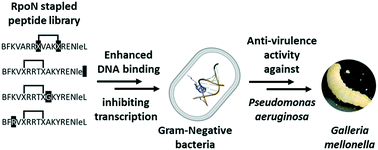RpoN-Based stapled peptides with improved DNA binding suppress Pseudomonas aeruginosa virulence†
Abstract
Stapled peptides have the ability to mimic α-helices involved in protein binding and have proved to be effective pharmacological agents for disrupting protein–protein interactions. DNA-binding proteins such as transcription factors bind their cognate DNA sequences via an α-helix interacting with the major groove of DNA. We previously developed a stapled peptide based on the bacterial alternative sigma factor RpoN capable of binding the RpoN DNA promoter sequence and inhibiting RpoN-mediated expression in Escherichia coli. We have elucidated a structure–activity relationship for DNA binding by this stapled peptide, improving DNA binding affinity constants in the high nM range. Lead peptides were shown to have low toxicity as determined by their low hemolytic activity at 100 μM and were shown to have anti-virulence activity in a Galleria mellonella model of Pseudomonas aeruginosa infection. These findings support further preclinical development of stapled peptides as antivirulence agents targeting P. aeruginosa.



 Please wait while we load your content...
Please wait while we load your content...